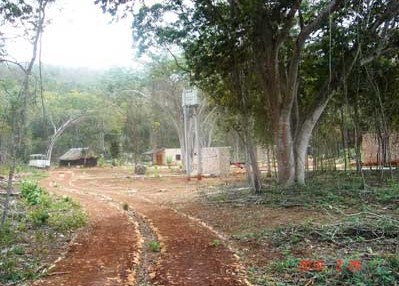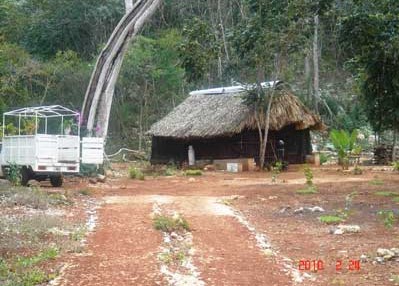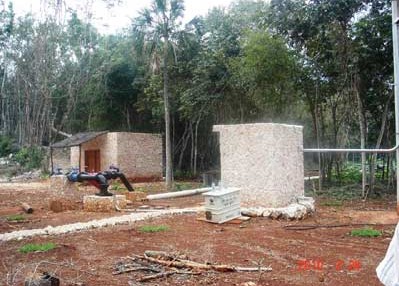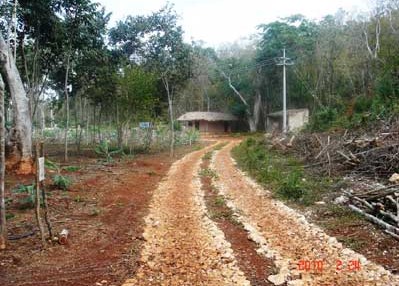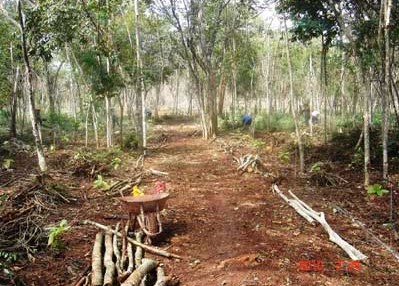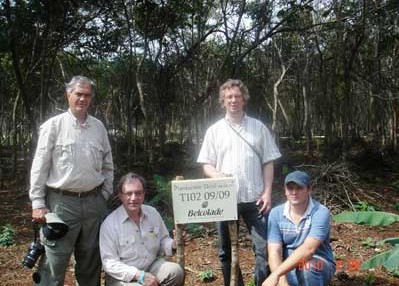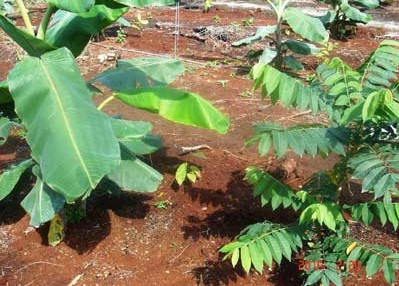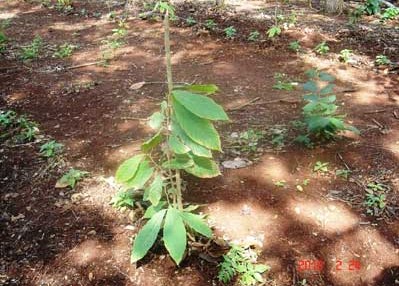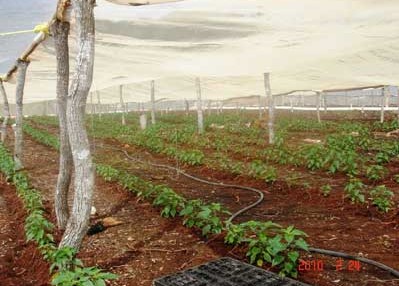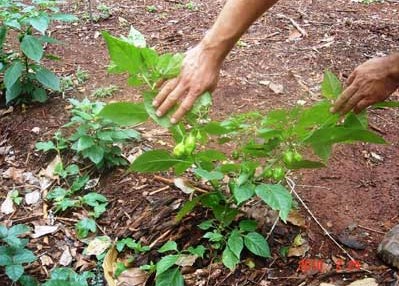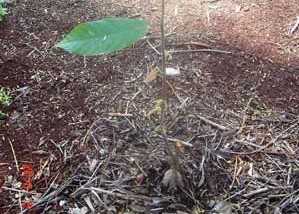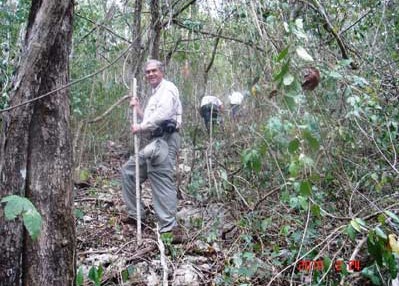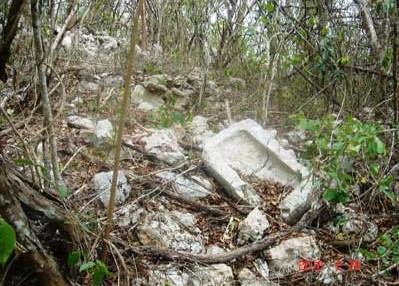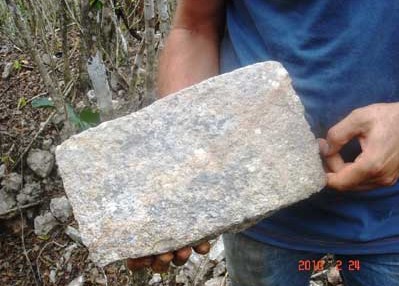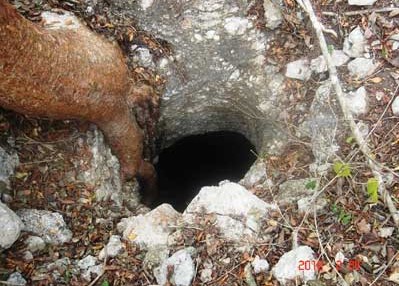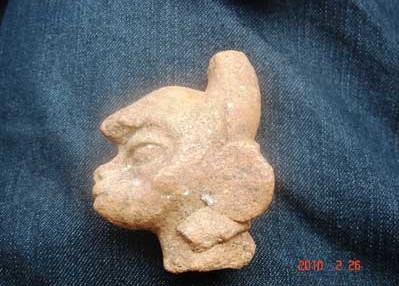The Tikul Plantation near Mérida
In October 2008, Belcolade gave the go ahead for development of the land bought in the Yucatan.
To remind you, the land is situated on the Puuc road between two Mayan sites: Xlapak and Labna.
It was therefore logical that on our site of 300 hectares there were also ruins.
In fact, there are ruins on every hill on the site. Recently, walls measuring over a metre in height were discovered. At the foot of them, we found metates, pieces of pottery, and an amulet.
It became the symbol and logo of the plantation.
The latter is growing from day to day. We have already planted 10 hectares of land (1000 cocoa trees per hectare, making 10,000 cocoa trees).
20 more hectares have been cleared and cedar and mahogany trees, amongst others, have been planted.
There are 20,000 cocoa trees that are ready to be grafted and planted on the 20 hectares.
In order to provide shade we have planted:
- 2,000 yucca (cassava)
- 4,000 banana trees
- 10,000 cedar trees
- 5,000 mahogany trees
This means that there is/will be a cocoa tree every 3 metres, a cedar tree every 6 metres and a mahogany tree every 12 metres.
We had to fight against a scourge of ants that cut the stems of the leaves of the cocoa trees to suck the sap.
Our fight against the ants was unsuccessful until we discovered that they lived inside the “dzizilche” trees that we had left standing to provide shade for the young cocoa trees. We had to cut them all down.
The varieties of cocoa that we grafted are either trinitario, rubio or criollo and therefore all of good quality.
But it will be 3 or 4 years before the first harvest.
That is why we planted "habanero chilli" (14,000 plants outdoors and 4,000 plants in a greenhouse) as the harvest of this crop should pay the costs of the plantation whilst we are waiting for the trees to mature.
I also think it is better to sell them than to eat them, because after having tried one small piece, my tongue and the roof of my mouth were on fire for hours.
Biodynamic cultivation
We practice biodynamic farming at the Tikul plantation.
Grafting is carried out when the moon is waxing and we harvest the pods when the moon is waning.
In point of fact, the lunar biodynamic calendar is more complicated than that, however.
Biodynamic calendar
To garden with the moon means to consider your plants as living organisms, not as inanimate objects. Plants consist mostly of water and are therefore subject to the indirect influence of the moon, just like tides. If the moon can raise the oceans, it is obvious that the sap will not be spared. As much has actually been shown by a study conducted by three biologists and the anatomist Ernst Zürcher of the Zurich Federal Polytechnic, published in Science in 1998.
An aware gardener will be able to use the lunar calendar to check the phases of the moon in order to sow, mow the lawn, and transplant flowers, but also to avoid gardening on a lunar node day, for instance. The detailed version of the calendar will provide perfectionists with the precise time of important events, constellations crossed, etc. so that they can combine these data to determine the ideal time to do their gardening.
Principe 1: waxing or waning
The lunar month, which lasts 29 days and a few hours, is composed of two parts:
- Between the New Moon (NM) and Full Moon (FM), the lunar disc increases day by day: the moon is said to be waxing.
- After full moon, when the disc decreases again until the New Moon: the moon is said to be waning.
- A waxing moon is indicated for:
- Work the land, proceed to transplants, plantings and seedlings of fruit- or grain-bearing plants;
- Planting trees and bushes in the orchard, and proceed to grafting and pruning.
- A waning moon is indicated for:
- Seedlings of all plants that cannot go to seed (lettuce, spinach, onions) and for harvesting;
- Pruning trees and bushes to decrease their vigour;
- Harvesting produce, because it will keep longer.
During the Full Moon period, for instance, the plants will contain a larger quantity of water, will absorb water better, and germination and growth will increase. The biodynamic calendar therefore recommends sowing 2 days before full moon, if possible.
Waxing or waning moon?
Question: How can you know whether the moon is waxing or waning by looking at the sky?
Answer for the Northern Hemisphere: If it looks like the letter C, the moon is waning. If it looks like the letter D, it is waxing.
Another mnemonic trick is to use the lower case letter p and d: if the moon cycle is starting:
| New moon | * |
| First quarter | p |
| Full moon | O |
| Last quarter | d |
Look at the curvature of the moon:
- If the curve looks like a p (as in premier (or first) quarter), the moon is waxing.
- If it looks like a d (as in the last letter of the word end), the moon is waning.
In the Southern hemisphere, the situation is reversed! So use C for waxing and D for waning.
Principle 2: rising and falling
Another important element to bear in mind is: rising moon and falling moon.
To simplify matters, the position of the moon on the horizon changes as the days progress. For a part of its cycle of 27 days and 8 hours, it seems to be “rising” for some 14 days, and then “falling” again. We say that the moon is rising when it is “above” the Sun’s orbit, and the moon is falling when it is “below” it (be careful not to confuse this with the previous point!).
To verify this phenomenon, choose a night and observe the position of the moon on the sky. Use a fixed point of reference, such as a tree, a church, a post, etc. and note its location. The next day, observe where the moon is. Is it higher or lower?
- During the period when the moon is rising:
- The sap of the plants rises to the branches. Those days are therefore beneficial for what happens above ground: grafting, seedlings, branch growth, etc.;
- All leafy vegetables (lettuce, spinach, chard, etc.) and the lawn have stimulated growth.
- Now is the time to sow your red beet, endives, chicory, gherkins, cucumbers and courgettes.
- The fruit harvested will be juicer and will stay fresh longer.
- During the period when the moon is falling:
- Conversely, when the moon is falling, the sap goes to the roots. This period is therefore indicated for what happens underground (planting, transplanting, rooting the cuttings that will thrive better, etc.), but also for pruning, which is supported better by the plants.
- If you decide to use green fertilisers, do so during this period.
- It is also the right time to harvest root vegetables (carrots, turnips, potatoes, radishes, etc.).
ATTENTION: The moon crosses the Sun’s orbital plan twice per lunar month. This is referred to as the lunar node, and you should refrain from gardening 4 hours before and 4 hours after this phenomenon. Very important: Have you already sown seeds that seem to take days, and even weeks at times before germinating? You may reasonably surmise that you acted under the influence of a node!
The moon’s orbit around the earth is an ellipse. At a particular point, the moon is farthest away from the earth. It is then said to have reached its apogee. Some 14 days later, the moon draws closest to us. It is then said to have reached its perigee (360,000 km from us). The difference between these two distances is 50,000 km. Take a break on the day of the apogee and of the perigee. At least 4 hours before and 4 hours after. When the moon is at its apogee, germination and growth of young plants are blocked. In its perigee, young seedlings would tend to “run.”
Tips: Take a close look at the lunar calendar; everything is indicated on it. The moon may be waxing and falling at the same time. Do not mix up these two notions.
